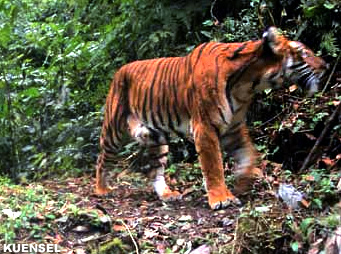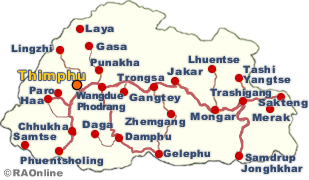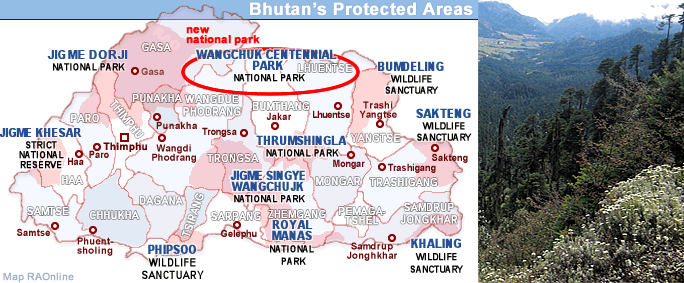| Bhutan's
Nature - Animals |
 |
Bhutan Nature Animals |
|
 |
Bhutan Information |
|
|
 |
|
Tiger
burning bright
|
 |
 |
| Sub-tropical Royal Bengal Tiger |
| The
six Bengal tigers (Panthera tigris tigris),
five adults and a cub, which were caught on camera in the Jigme Singye
Wangchuck National Park in central Bhutan between September 2006 and
May this year gave an insight into the otherwise elusive territory of the
large cats, say officials of the Nature Conservation Division (NCD) in
Thimphu. |
|
The
camera trapping was one of the initial steps towards conducting a comprehensive
study to understand the ecology of tigers living in Bhutan's mountain habitats,
distribution and ecology of their prey, and the relationships between tigers
and humans.
"Very
little is known about the tigers in Bhutan," said the head of NCD, Sonam
Wangyel Wang. "Successful conservation of tigers, which has been initiated
since late 90s, is only possible with such scientific studies and plans
in place."
With
the initial focus on the Jigme Singye Wangchuck National Park, the
division hopes to carry out similar studies in the other wildlife sanctuaries
like the Jigme Dorji Wangchuck and the Manas National Park, which are also
home to the Royal Bengal tigers.
 |
| Through
the study the conservationists also hope to come out with solutions to
the increasing human-wildlife conflict. The age-old tradition of livestock
rearing, moving livestock to higher elevations in summers and back to the
lower grounds in winter, worsened the conflict with grazing cattle left
free to predators' attacks. Free-ranging livestock were very attractive
prey for the tigers living in the same forests, especially where wild deer,
pigs, and other prey were difficult to come by in the rugged terrain. |
|
The
protected habitats of the carnivores in Bhutan were also closely shared
by farmers living in these areas before they became protected habitats.
The co-existence was beginning to become a source of conflict where several
incidents of tigers and other carnivores' attacks on livestock and cattle
had been reported, and in retaliation the farmers, sometimes killed them.
But
finding solutions was not easy. "To find solutions to these problems we
have to have good science to learn about these predators ecology, habitat
and behaviour which is currently missing," said Sonam Wangyel. "Once we
have all the data on the tiger, their prey species as well as how humans
interact with wildlife, then we will be able to draw up some good strategies
to mitigate conflicts."
Earmarked
as one of the 'fully protected' species in the Forest and Nature Conservation
Act, 1995, tigers in Bhutan are revered as one of the mythical animals
and protectors. People respect them and
equate them to local deities.
While
exact numbers are not known, the tiger population in Bhutan is estimated
between 115 and 150, including juveniles. Tigers are found in almost all
parts of the country, cited in areas ranging from 100 metres above sea
level to as high as 4,100 metres in the north. to as high as 4,100 metres
in the north.
| Contributed
by KUENSEL, Bhutan's National Newspaper 2007 |
 |
top
| Wildlife and People in Bhutan |
 |
| Information on Bhutan |
 |
| Links |
 |
 |
 |
External
links |
|
|





